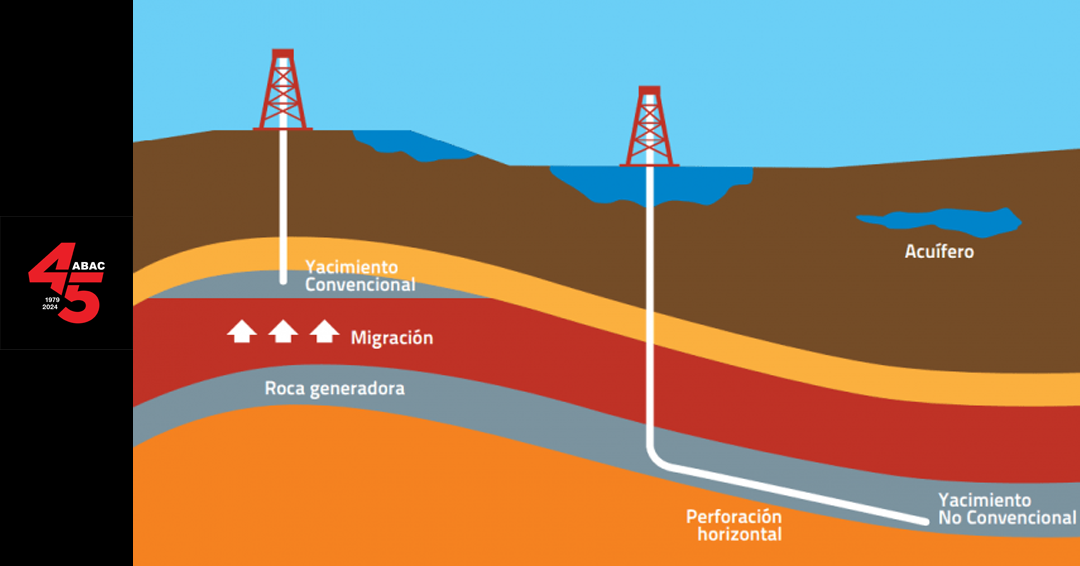
In this note, we explain what “conventional” and “unconventional” hydrocarbons are, as well as the main difference between the two, which doesn’t really have to do with gas and oil themselves, but with the type of rock they’re found in.
“Conventional” hydrocarbons, which have been traditionally extracted for over a century, are essentially the same as those termed “unconventional.” The key difference is how they are stored, both gas and oil. In fact, for the industry, all hydrocarbons that aren’t found in “conventional” formations are regarded as “unconventional.” This means there are various kinds of “unconventional” hydrocarbons.
For years, operations focused on looking for and extracting oil and gas that were trapped underground in the microscopic pores of “permeable” rocks—meaning their pores are interconnected. Just like in a sponge, fluids (gas and oil) can move between these pores. In other words, they can “travel” inside these formations, normally heading toward the surface. Sometimes, they get “trapped” by an impermeable rock that prevents them from passing through (because its pores are isolated from one another). That’s what a conventional hydrocarbon reservoir looks like: a permeable reservoir rock, where the stored hydrocarbons are trapped by an impermeable “seal” rock. Anything that deviates from this pattern is considered “unconventional.”
In Argentina, when we talk about “unconventional,” we specifically refer to two types of hydrocarbons: those from “shale” formations, like Vaca Muerta, and those from “tight” formations. In both cases, these are very compact formations. The “tight” ones have low permeability, while the “shale” ones are basically impermeable.
In the case of “shale” (which geologists identify as mudstones and marls), we’re looking at rocks formed from the beds of lakes and seas. Over millions of years, the trapped organic material (remains of microorganisms, algae, animals, etc.) turned into gas and oil. That’s why it’s common to read or hear that “shale” is also called “source rock” or “mother rock.”
This last term, “mother rock,” can be confusing. It doesn’t refer to the planet Earth’s mother rock or a kind of baseline rock, but rather to just a layer that can be tens to hundreds of meters thick, where gas and oil formed. It’s just the “mother rock” of hydrocarbons. Below it, there are dozens to hundreds of kilometers of rock formations extending down to the Earth’s mantle.
This source rock (shale) has become fractured through natural physico-chemical processes. In some cases, through these fractures, part of the hydrocarbons migrated, generally toward the surface (some made it, others got trapped in what we call “traps” or conventional reservoirs). But a good portion of the hydrocarbons remained trapped in the source rock.
In Argentina, talking about extracting “shale gas” and “shale oil” means specifically going to look for hydrocarbons right there, in the formations where they were generated, which haven’t migrated to permeable formations or conventional reservoirs.
Since gas and oil are distributed in millions of microscopic pores that, unlike conventional reservoirs, are not interconnected, they can’t move within the formation. Therefore, it’s necessary to artificially create pathways for them to flow toward the well.
Essentially, it’s about reopening the tiny fractures in the source rock, created by nature during the formation of hydrocarbons, which are now closed off by the weight of kilometers of rock resting on top of them.
For this, a technique known as hydraulic stimulation, hydraulic fracturing, or fracking is used, which was developed nearly 80 years ago and has been regularly utilized in our country over the last fifty years (to enhance the permeability of conventional reservoirs). This process involves injecting a fluid, mainly made up of water and sand (99.5%), with a small amount of some extremely diluted chemical additives (0.5%), at high pressure.
Once the fracture is reopened thanks to the pressure of the water, it’s necessary to ensure that it doesn’t close again when the pressure decreases. That’s why a “proppant” (special sand) is added to the water. This proppant enters the fractures and supports them to prevent them from closing back up. From that moment on, hydrocarbons can flow through these fractures, which are less than a millimeter thick, supported by the grains of sand, toward the well for extraction.
We also mentioned the “tight” formations or “tight sands.” Here, we’re talking about non-generating formations, unlike the shale. In fact, they received hydrocarbons that were generated in shale formations, but their pores are very poorly interconnected (very low permeability). In this case, hydraulic stimulation (fracking) is also necessary to improve permeability, but on a smaller scale.
So, it’s worth noting that the extraction of both conventional and unconventional hydrocarbons has many points in common (like well drilling, for example), and the only difference is that the latter absolutely requires hydraulic stimulation (fracking), although today, practically all wells, whether conventional or not, undergo this operation.






